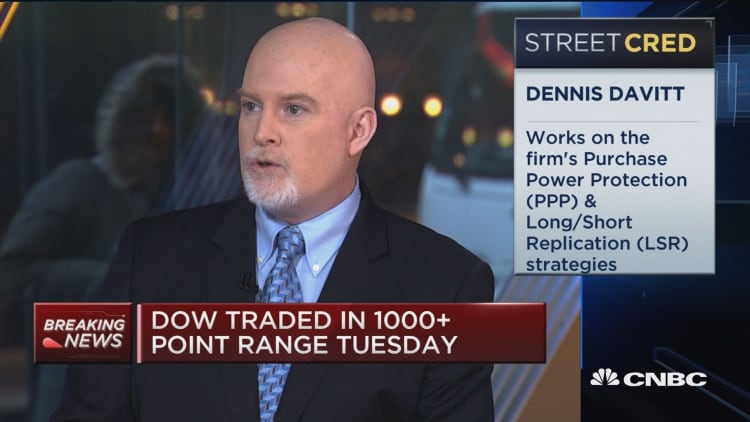
The volatility storm that has rocked the market could be just getting started if historical trends hold up.
Products that track market volatility took focus as the market endured its first meaningful pullback in two years. Exchange-traded products that bet against market tumult have gotten shellacked and some even have liquidated.
Seeing such behavior in February, though, isn't consistent with market patterns over the past few decades, according to DataTrek Research. The firm, in fact, found that the most popular fear gauge on Wall Street, CBOE's VIX volatility index, has only peaked once in February since its 1990 inception.
"U.S. equity market volatility is deeply informed by seasonality," DataTrek founder Nick Colas said in his daily note Wednesday.
The VIX spiked past 46 during a whipsaw trading day Tuesday before closing around 37. While many investors likely are hoping that the dizzying movements are the worst of the year, the calendar doesn't back that up.
That's because the measure has peaked for the year in February only once during its existence — interestingly, the only other time was during the market's early 2016 upset.
Most of the other peaks have been concentrated around August and October, which have 36 percent of the annual highs. Adding January brings that total to 50 percent.
In 2018, that trend is particularly notable because of the November midterm elections. Republicans will be fighting to fend off what could be a formidable challenge from Democrats looking to capitalize on a different type of volatility — the political type, which has seen President Donald Trump's approval rating hover around the 40 percent range.
"August of this year will coincide with the peak of the campaigning around midterm elections in the U.S. It will also be enough time to see the true effects of the recently passed tax reform package on consumer spending and business investment," Colas wrote. "And it is also a typical month for peak volatility."
So while the VIX tumbled off its peak Wednesday and moved closer to its long-term average near 20, history argues that there's more volatility to come. That's bad news for the exchange-traded products that bet against volatility, such as the ProShares Short VIX Short-Term Futures and the VelocityShares Daily Inverse VIX Short-Term ETN.
Both products use leverage to play against volatility and have raised concerns this week over the effect exotic exchange-traded products could have on market stability.
Investors, then, would do well to keep the early-year churn in mind and position accordingly.
"Our central investment theme is that the narrative around U.S. equities has shifted from simple (higher earnings and stable rates) to complex (the effects of tax reform on inflation and interest rates, the direction of the dollar, and uncertainties over stock valuation)," Colas wrote. "Higher volatility is a natural extension of this shift."
WATCH: The short-volatility trade was just one aspect of the recent sell-off.



